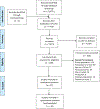Non-invasive bladder function measures in healthy, asymptomatic female children and adolescents: A systematic review and meta-analysis
- PMID: 34090791
- PMCID: PMC8502197
- DOI: 10.1016/j.jpurol.2021.04.020
Non-invasive bladder function measures in healthy, asymptomatic female children and adolescents: A systematic review and meta-analysis
Abstract
Background: Lower urinary tract symptoms (LUTS) are common in children and adolescents. Non-invasive tests evaluating bladder function are generally preferred over invasive tests, yet few studies have explored the range of normative values for these tests in healthy, asymptomatic children.
Objective: To define normative reference ranges for non-invasive tests of bladder function in healthy, asymptomatic girls and adolescents.
Study design: A comprehensive search strategy was performed in seven electronic databases through October 2019. English-language studies reporting data on voiding frequency, voided and postvoid residual volumes (PVR) and uroflowmetry results in healthy, asymptomatic girls (mean age ≥ 5 years) were included. Two independent reviewers performed study review, data extraction, and quality assessment. Overall mean estimates and 95% confidence intervals for each bladder function parameter were calculated using random effects models, and 95% normative reference values were estimated.
Results: Ten studies met eligibility criteria for the meta-analysis (n = 2143 girls, age range: 3-18). Mean estimates of maximum voided volume and PVR were 233.4 ml (95% CI 204.3-262.6; n = 1 study) and 8.6 ml (95% CI 4.8-12.4; n = 2 studies) respectively. Pooled mean estimates for uroflowmetry parameters were: 21.5 ml/s (95% CI 20.5-2.5) for maximum flow rate (n = 6 studies), 12.5 ml/s (95% CI 11.2-13.8) for mean flow rate (n = 6 studies), 6.8 s (95% CI 4.4-9.3) for time to maximum flow (n = 3 studies), 15.7 s (95% CI 13.0-18.5) for flow time (n = 3 studies), and 198.7 ml (95% CI 154.2-234.2) for voided volume (n = 9 studies). No studies reported estimates of voiding frequency. Between-study heterogeneity was high (89.0-99.6%).
Conclusions: Although we were able to calculate pooled mean estimates for several parameters, the small number of included studies and the wide age ranges of participants preclude generalization of reference values to all healthy girls. Further research is needed to determine normative reference values within specific age groups.
Keywords: Children; Reference values; Urinary volume; Uroflowmetry; Voided volume; Voiding.
Copyright © 2021 Journal of Pediatric Urology Company. Published by Elsevier Ltd. All rights reserved.
Conflict of interest statement
Conflicts of interest The authors report no conflicts of interest.
Figures
References
-
- Vaz G, Vasconcelos M, Oliveira E, Ferreira A, Magalhaes P, Silva F and Lima E, Prevalence of lower urinary tract symptoms in school-age children. Pediatric Nephrology, 2012. 27(4): p. 597–603. - PubMed
-
- Akil IO, Ozmen D and Cetinkaya AC, Prevalence of urinary incontinence and lower urinary tract symptoms in school-age children. Urology Journal, 2014. 11(3): p. 1602–1608. - PubMed
-
- Petrangeli F, Capitanucci ML, Marciano A, Mosiello G, Alvaro R, Zaccara A, Finazzi-Agro E and De Gennaro M, A 20-year study of persistence of lower urinary tract symptoms and urinary incontinence in young women treated in childhood. J Pediatr Urol, 2014. 10(3): p. 441–445. - PubMed
-
- Harlow BL, Bavendam TG, Palmer MH, Brubaker L, Burgio KL, Lukacz ES, Miller JM, Mueller ER, Newman DK, Rickey LM, Sutcliffe S, and Simons-Morton D, The Prevention of Lower Urinary Tract Symptoms (PLUS) Research Consortium: A Transdisciplinary Approach Toward Promoting Bladder Health and Preventing Lower Urinary Tract Symptoms in Women Across the Life Course. Journal of Women’s Health, 2018. 27(3): p. 283–289. - PMC - PubMed
-
- Lowder JL, Bavendam TG, Berry A, Brady SS, Fitzgerald CM, Fok CS, Goode PS, Lewis CE, Mueller ER, Newman DK, Palmer MH, Rickey LM, Stapleton A, and Lukacz ES, Terminology for bladder health research in women and girls: Prevention of Lower Urinary Tract Symptoms transdisciplinary consortium definitions. Neurourology and Urodynamics, 2019. 38(5): p. 1339–1352. - PMC - PubMed
Publication types
MeSH terms
Grants and funding
LinkOut - more resources
Full Text Sources
Medical
Research Materials
Miscellaneous


